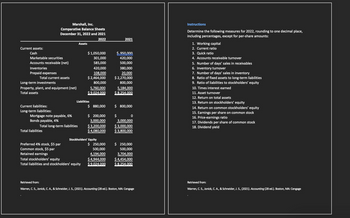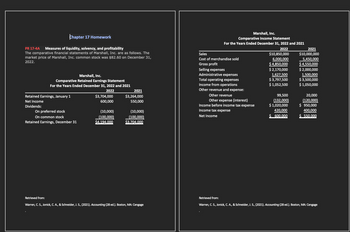
FINANCIAL ACCOUNTING
10th Edition
ISBN: 9781259964947
Author: Libby
Publisher: MCG
expand_more
expand_more
format_list_bulleted
Concept explainers
Topic Video
Question
1. Find the Ratio of FIxed Assets to long term liabilities
2. Find the ratio of liabilities to
Look at the pictures, then answer the question please! thank you in adavance.

Transcribed Image Text:Current assets:
Cash
Marketable securities
Accounts receivable (net)
Inventories
Prepaid expenses
Marshall, Inc.
Comparative Balance Sheets
December 31, 2022 and 2021
2022
Total current assets
Long-term investments
Property, plant, and equipment (net)
Total assets
Current liabilities:
Long-term liabilities:
Mortgage note payable, 6%
Bonds payable, 4%
Total liabilities
Total long-term liabilities
Preferred 4% stock, $5 par
Common stock, $5 par
Retained earnings
Assets
$ 1,050,000
301,000
585,000
420,000
108,000
$ 2,464,000
Liabilities
Total stockholders' equity
Total liabilities and stockholders' equity
800,000
5,760,000
$9.024.000
$ 880,000
$ 200,000
3,000,000
$3,200,000
$ 4,080,000
Stockholders' Equity
$ 250,000
500,000
4,194,000
$ 4,944,000
$9.024.000
2021
$ 950,000
420,000
500,000
380,000
20,000
$ 2,270,000
800,000
5,184,000
$ 8.254.000
$ 800,000
$
0
3,000,000
$3,000,000
$ 3,800,000
$ 250,000
500,000
3,704,000
$ 4,454,000
$ 8.254.000
Retrieved from:
Warren, C. S., Jonick, C. A., & Schneider, J. S., (2021). Accounting (28 ed.). Boston, MA: Cengage
Instructions
Determine the following measures for 2022, rounding to one decimal place,
including percentages, except for per-share amounts:
1. Working capital
2. Current ratio
3. Quick ratio
4. Accounts receivable turnover
5. Number of days' sales in receivables
6. Inventory turnover
7. Number of days' sales in inventory
8. Ratio of fixed assets to long-term liabilities
9. Ratio of liabilities to stockholders' equity
10. Times interest earned
11. Asset turnover
12. Return on total assets
13. Return on stockholders' equity
14. Return on common stockholders' equity
15. Earnings per share on common stock
16. Price-earnings ratio
17. Dividends per share of common stock
18. Dividend yield
Retrieved from:
Warren, C. S., Jonick, C. A., & Schneider, J. S., (2021). Accounting (28 ed.). Boston, MA: Cengage

Transcribed Image Text:Chapter 17 Homework
PR 17-4A Measures of liquidity, solvency, and profitability
The comparative financial statements of Marshall, Inc. are as follows. The
market price of Marshall, Inc. common stock was $82.60 on December 31,
2022.
Marshall, Inc.
Comparative Retained Earnings Statement
For the Years Ended December 31, 2022 and 2021
2022
Retained Earnings, January 1
Net Income
Dividends:
On preferred stock
On common stock
Retained Earnings, December 31
$3,704,000
600,000
(10,000)
(100,000)
$4.194.000
2021
$3,264,000
550,000
(10,000)
(100,000)
$3.704.000
Retrieved from:
Warren, C. S., Jonick, C. A., & Schneider, J. S., (2021). Accounting (28 ed.). Boston, MA: Cengage
Marshall, Inc.
Comparative Income Statement
For the Years Ended December 31, 2022 and 2021
2022
$10,850,000
6.000.000
$ 4,850,000
$ 2,170,000
1,627,500
$ 3,797,500
$ 1,052,500
Sales
Cost of merchandise sold
Gross profit
Selling expenses
Administrative expenses
Total operating expenses
Income from operations
Other revenue and expense:
Other revenue
Other expense (interest)
Income before income tax expense
Income tax expense
Net Income
99,500
(132,000)
$ 1,020,000
420,000
$ 600.000
2021
$10,000,000
5,450,000
$ 4,550,000
$ 2,000,000
1,500,000
$ 3,500,000
$ 1,050,000
20,000
(120,000)
$ 950,000
400,000
$ 550.000
Retrieved from:
Warren, C. S., Jonick, C. A., & Schneider, J. S., (2021). Accounting (28 ed.). Boston, MA: Cengage
Expert Solution
This question has been solved!
Explore an expertly crafted, step-by-step solution for a thorough understanding of key concepts.
Step by stepSolved in 2 steps

Knowledge Booster
Learn more about
Need a deep-dive on the concept behind this application? Look no further. Learn more about this topic, accounting and related others by exploring similar questions and additional content below.Similar questions
- Which of the following will result when a dividend is paid? A debit to dividends payable. A credit to dividends payable. A debit to capital. A credit to capital.arrow_forwardDirections: Fill in the following table using the equation: ∆Cash = - ∆Noncash Assets + ∆Liabilities + ∆Stockholders Equity. Indicate the name of the noncash asset, liability, or equity account affected by the transaction and if change in cash is classified as operating (O), investing (I), financing (F), or noncash (NC). The first line has been completed for you as an exampleItem∆Cash = - ∆Noncash Assets + ∆Liabilities + ∆Stockholders Equity1. Prepaid office rent for cash -O = - + Prepaid Rent + + 2. Sale of land held for cash = - + + 3. Cash payment of taxes payable = - + + 4. Issue preferred stock to investors for cash = - + + 5. Purchase equipment that is financed directly by the seller = - + + 6. Paid cash dividend = - + + 7. Pay notes payable = - + + 8. Pay interest payable = - + +arrow_forwardfind assets, liabilities, and stockholders equityarrow_forward
- How to calculate working capital, current assests, current liabilities, quick assets, quick ratio and current ratio.arrow_forwardIdentify whether the statement are True or False. 1. Insurance companies use replacement value as a basis to determine the appropriate insurance premium to be charged to their clients. * 2. To get book value per share, total liabilities are deducted from total assets, and the resulting figure is divided by total authorized shares * 3. For real properties, it is more important to look at the age of the asset than its size. * 4. Fair Market value is the term used to describe the value derived from the amounts reflected in the financial statements. * 5. Risk identification is important to allow investors to assess the impact of the risk on their investment. * 6. Brownfield investments are easier to evaluate as information is already available from prior years * 7. The book value method is a transparent approach since value can be easily verified by looking at the financial statements * 8. If there are no comparable assets found in the market, it is more appropriate to use the replacement…arrow_forwardWhich among the following is an example of a personal financial statement? Select one: O a. Budgeting b. None of the option c. Insurance O d. Income and Expense Statement O e. Bank Loan Clear my choicearrow_forward
- a) Calculate the equity (total asset – total liability) to asset ratio of the bank (Hint: equity to asset ratio = total equity/total asset) %3D b) Calculate the duration and convexity of the both asset and liability sidesarrow_forward(participation expected < You would find asset, liability, and equity accounts on which of the following statements? OA. Statement of cash flows B. Balance sheet OC. Statement of retained earnings OD. Income statementarrow_forwardPlease help with a, b, and c.arrow_forward
- Which are the Important Issues in Accounting and Financial Disclosure: Equity REITs2arrow_forwardQ: Explain Following Financial terms•:1) Financial Environment2) Financial planning3) Annuity & itstypes4) TVM5) Business Riskarrow_forwardMost of the users of financial statements are concerned about what will happen in the future. Explain the statement with an example?arrow_forward
arrow_back_ios
SEE MORE QUESTIONS
arrow_forward_ios
Recommended textbooks for you

 AccountingAccountingISBN:9781337272094Author:WARREN, Carl S., Reeve, James M., Duchac, Jonathan E.Publisher:Cengage Learning,
AccountingAccountingISBN:9781337272094Author:WARREN, Carl S., Reeve, James M., Duchac, Jonathan E.Publisher:Cengage Learning, Accounting Information SystemsAccountingISBN:9781337619202Author:Hall, James A.Publisher:Cengage Learning,
Accounting Information SystemsAccountingISBN:9781337619202Author:Hall, James A.Publisher:Cengage Learning, Horngren's Cost Accounting: A Managerial Emphasis...AccountingISBN:9780134475585Author:Srikant M. Datar, Madhav V. RajanPublisher:PEARSON
Horngren's Cost Accounting: A Managerial Emphasis...AccountingISBN:9780134475585Author:Srikant M. Datar, Madhav V. RajanPublisher:PEARSON Intermediate AccountingAccountingISBN:9781259722660Author:J. David Spiceland, Mark W. Nelson, Wayne M ThomasPublisher:McGraw-Hill Education
Intermediate AccountingAccountingISBN:9781259722660Author:J. David Spiceland, Mark W. Nelson, Wayne M ThomasPublisher:McGraw-Hill Education Financial and Managerial AccountingAccountingISBN:9781259726705Author:John J Wild, Ken W. Shaw, Barbara Chiappetta Fundamental Accounting PrinciplesPublisher:McGraw-Hill Education
Financial and Managerial AccountingAccountingISBN:9781259726705Author:John J Wild, Ken W. Shaw, Barbara Chiappetta Fundamental Accounting PrinciplesPublisher:McGraw-Hill Education


Accounting
Accounting
ISBN:9781337272094
Author:WARREN, Carl S., Reeve, James M., Duchac, Jonathan E.
Publisher:Cengage Learning,

Accounting Information Systems
Accounting
ISBN:9781337619202
Author:Hall, James A.
Publisher:Cengage Learning,

Horngren's Cost Accounting: A Managerial Emphasis...
Accounting
ISBN:9780134475585
Author:Srikant M. Datar, Madhav V. Rajan
Publisher:PEARSON

Intermediate Accounting
Accounting
ISBN:9781259722660
Author:J. David Spiceland, Mark W. Nelson, Wayne M Thomas
Publisher:McGraw-Hill Education

Financial and Managerial Accounting
Accounting
ISBN:9781259726705
Author:John J Wild, Ken W. Shaw, Barbara Chiappetta Fundamental Accounting Principles
Publisher:McGraw-Hill Education